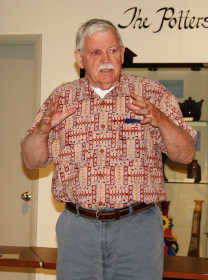Forest Hill Cemetery more jewel than diamond in rough

To the average person on the street, Forest Hill Cemetery comes to mind as a quaint, well-manicured expanse of green. Or a final resting place for a beloved relative or two or three.
But there is more to it than that. Much more, according to a Hoosier preservation expert who has been examining the cemetery and its environs and amenities for the Heritage Preservation Society of Putnam County.
Not all communities are as lucky as Greencastle to possess a cemetery as historic and well designed and intriguing as Forest Hill, preservation expert John Warner of Indianapolis told a small but enthusiastic group of Heritage Preservation Society members recently at the Putnam County Museum.
With its gentle slopes, curved paths and roadways and historic features, Forest Hill is a good candidate for the National Register of Historic Places, Warner said.
If you've been to cemeteries in other communities, he noted, it is apparent that most of them don't have the welcoming serenity inherent in the rolling terrain at Forest Hill.
Cemeteries in many locales have evolved from more ornate resting places into more sterile, uninspired memorial parks with flush grave markers, Warner pointed out.
Not so Forest Hill, he assured, noting that its Historic Register application is supported by a number of elements included in the design.
The art deco-style Forest Hill Abbey, for example, was built of white marble in 1931. Although called an abbey, it was essentially a mausoleum and serves as the final resting place of notable local residents, including Greencastle High School basketball legend Jess McAnally, for whom McAnally Center was posthumously named.
Another contributing factor, Warner said, are the stone bridges throughout the cemetery, built during the period 1885-1890.
"These are really good examples of stone-arch bridges," Warner said, "and since they don't get a lot of traffic on them, they'll probably be there a long time."
A pair of Victorian period crypts also are noteworthy at Forest Hill for being cut into the hillsides of the cemetery.
The crypts bear the names of the Goulding family (W.O. Goulding was a partner of John Ireland of Ireland House fame on Anderson Street, west of the new DePauw campus entrance) and the Overstreets (a family of dentists who served the Greencastle area for decades).
Also noted in Warner's assessment of the cemetery are the cast-iron fence that marks the northwest corner of the site and the Daughters of the American Revolution (DAR) Monument.
But the pièce de résistance for Forest Hill remains the historic Civil War Soldiers Monument, standing 30-feet tall and bearing the names of 321 Putnam County soldiers who died during the War Between the States.
The ongoing project to restore the Civil War Monument is under substantive review presently by the Division of Historic Preservation and Archaeology within the Department of Natural Resources, HPS spokesman Phil Gick said.

Once over that hurdle, it heads for the State Preservation Board, which meets quarterly, to compete for possible grant funding that could provide 50 percent of the funding for what is seen as a $120,000 renovation project.
The soldiers section in which the rare monument is located at Forest Hill is guarded at its four corners by four brass pre-Civil War cannons, three of which were manufactured during the period 1841-46 by N.P. Ames of Springfield, Mass.
The grave markers for the military personnel buried there cover several period of conflict, Warner said, noting that Revolutionary War veteran Sgt. Cunningham's marker is there along with a mixture of veterans of the Civil War, Spanish-American War and two World Wars.
Warner reported that Greencastle bought the land for Forest Hill Cemetery in 1863 with the old cemetery (near Blackstock Stadium) nearly full at the time. The land cost $1,300.
"The directive to the city engineer," Warner said, "was to 'go find a gardener and get it laid out.'"
City officials found William Tinsley of Cincinnati, a well-known architect who had built and designed the Larabee house in Greencastle.
After some reported haggling over his fee, Tinsley was paid the princely sum of $60 to design Forest Hill Cemetery and lay the groundwork for the historic setting it is today.
"One of the things you see in Victorian-type cemeteries," Warner said, "is a garden setting, a park-like setting, as opposed to an austere place where people were buried."
Warner, whose background research and field studies were instrumental in placement of three Greencastle neighborhoods -- Northwood, Old Greencastle and the Eastern Enlargement -- onto the National Register previously, said Forest Hill is a microcosm of Putnam County life.
"It contains the graves of babies, local families, even a man who was hit and run over on the railroad," he said. "It's history of the community, and that's the way I wrote the nomination.
"So remember," he concluded with a smile, "you got your cemetery (design) for $60."
